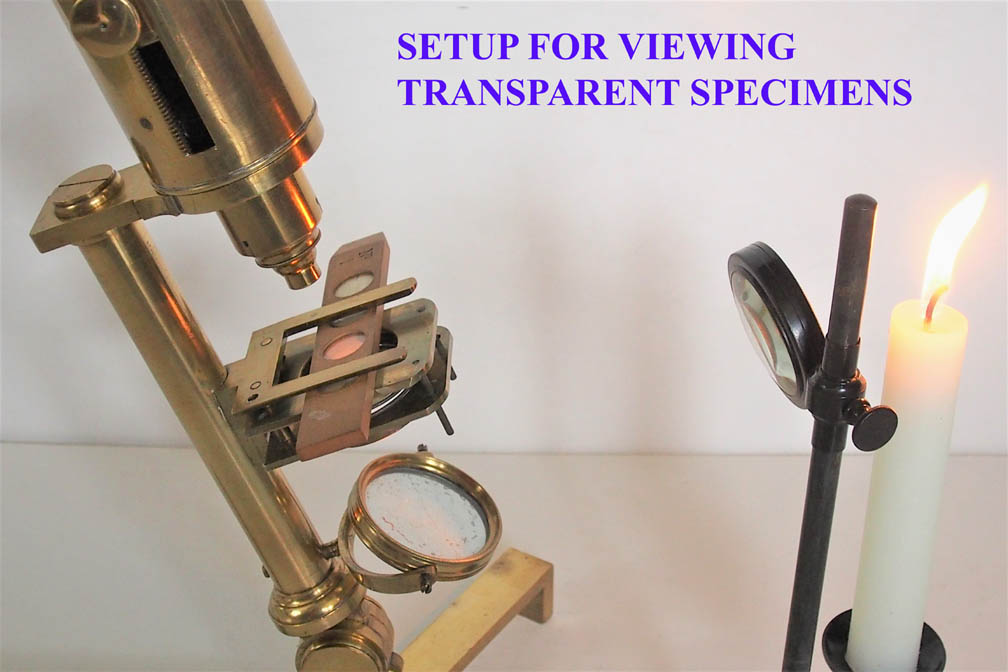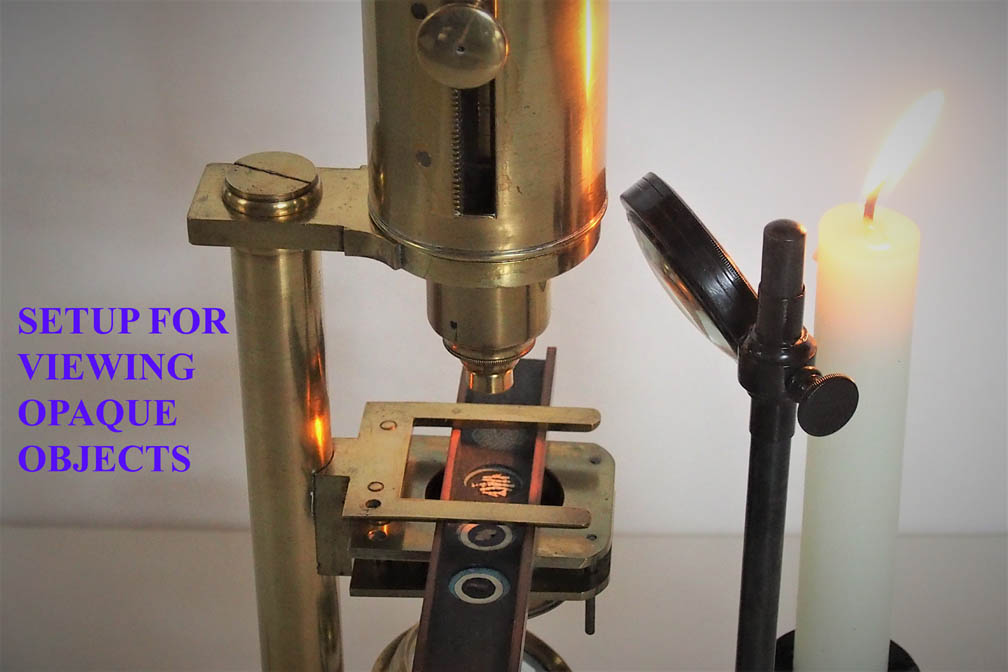OPTICAL DATA OBTAINED WITH STAGE MICROMETER AND CHESHIRE APERTOMETER:
| OBJECTIVE | APPROXIMATE N.A. | MAGNIFICATION WITH EYEPIECE |
|---|
| No. 6 |
0.04 |
26 |
| No. 5 |
0.05 |
35 |
| No. 4 |
0.06 |
50 |
| No. 3 |
0.08 |
63 |
| No.2 |
0.08 |
92 |
| No. 1 |
0.11 |
280 |
| Achr button1 |
0.11 |
108 |
| Achr button 1 +2 |
0.28 |
216 |
OTHER ACCESSORIES:
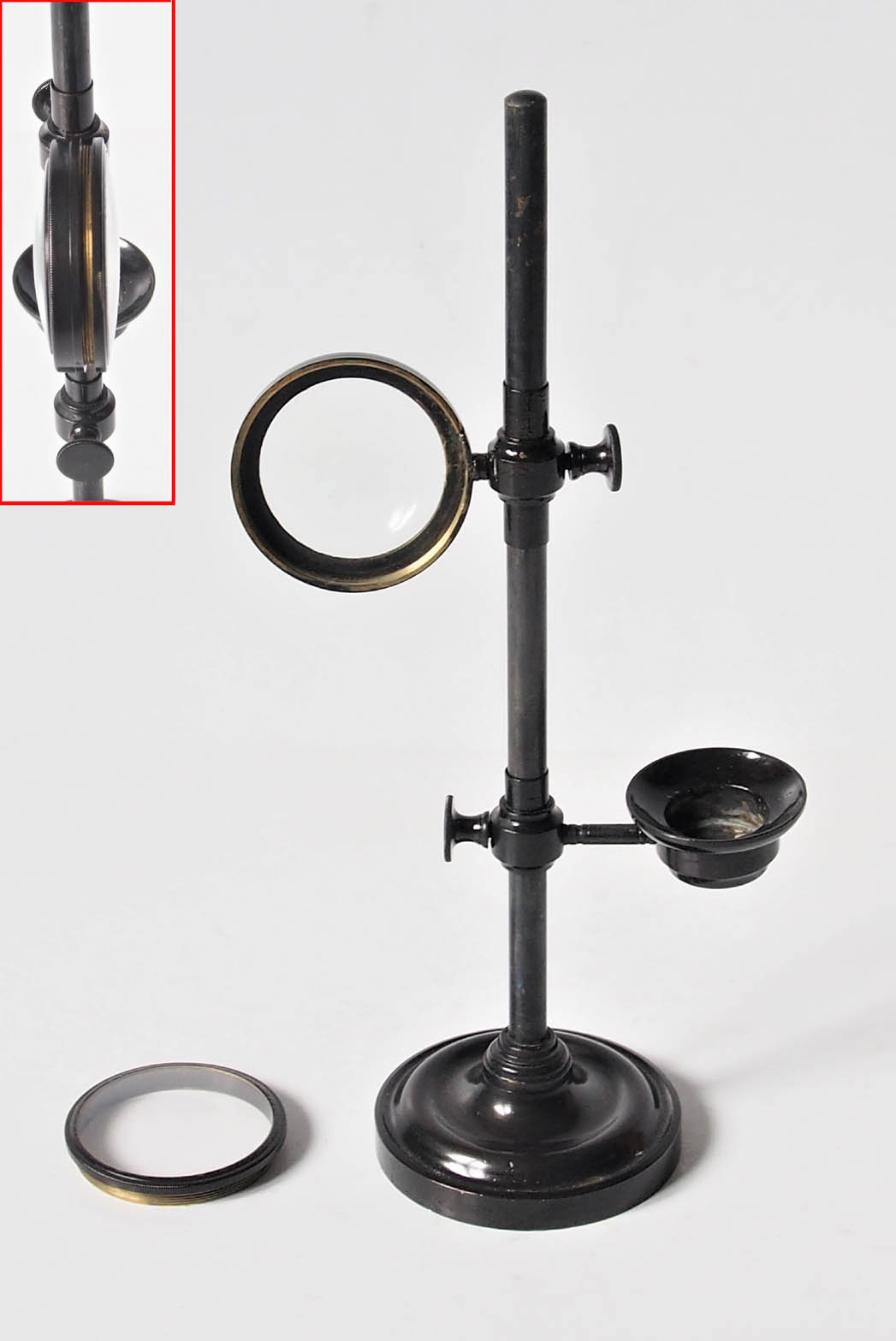 These include a slip-on brass collar with Lieberkuhn at the end, hand magnifier, live box, a small brass box, stage forceps, tweezers, a glass trough with brass rim, and a diaphragm stop to be inserted under the stage. There is also a combined candle stand and bullseye condenser finished in oxidized brass. This uncommon and uniquely-Carpenter type of illuminant features a two component, screw-together lens, the components to be used together for opaque specimens, but just one for illuminating the mirror.
These include a slip-on brass collar with Lieberkuhn at the end, hand magnifier, live box, a small brass box, stage forceps, tweezers, a glass trough with brass rim, and a diaphragm stop to be inserted under the stage. There is also a combined candle stand and bullseye condenser finished in oxidized brass. This uncommon and uniquely-Carpenter type of illuminant features a two component, screw-together lens, the components to be used together for opaque specimens, but just one for illuminating the mirror.
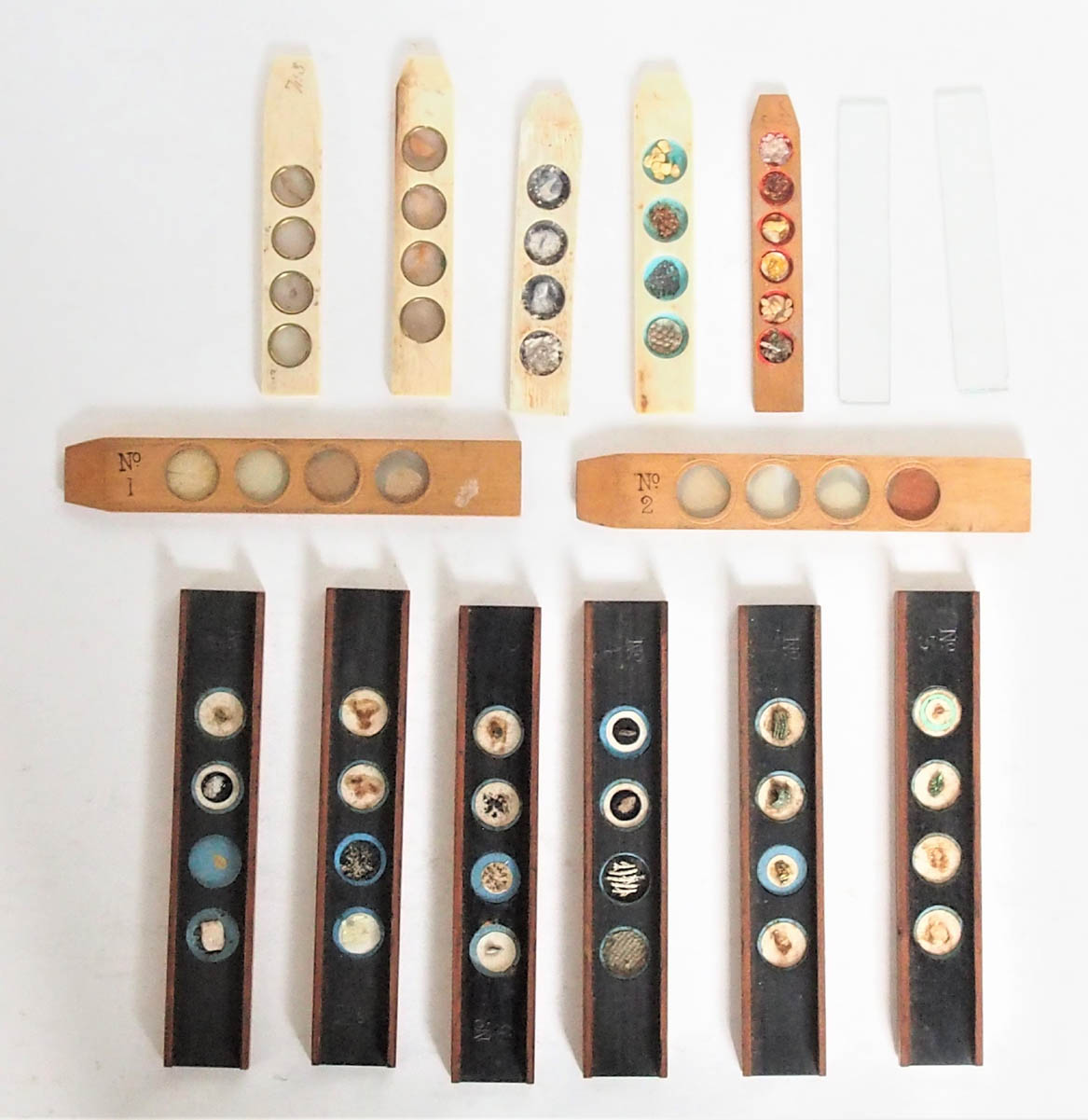
The set comes complete with three sets of slides,each accommodated under the lift-out tray in the case: a number of bone sliders with transparent objects, two larger wooden slides with transparent wood sections, and six sliders with raised edges containing opaque specimens. A replica candle shade was also made by the present owner. The only accessory missing from this set is the double-ended brass talc and split-ring container otherwise known as a
talc box
.
CASE:
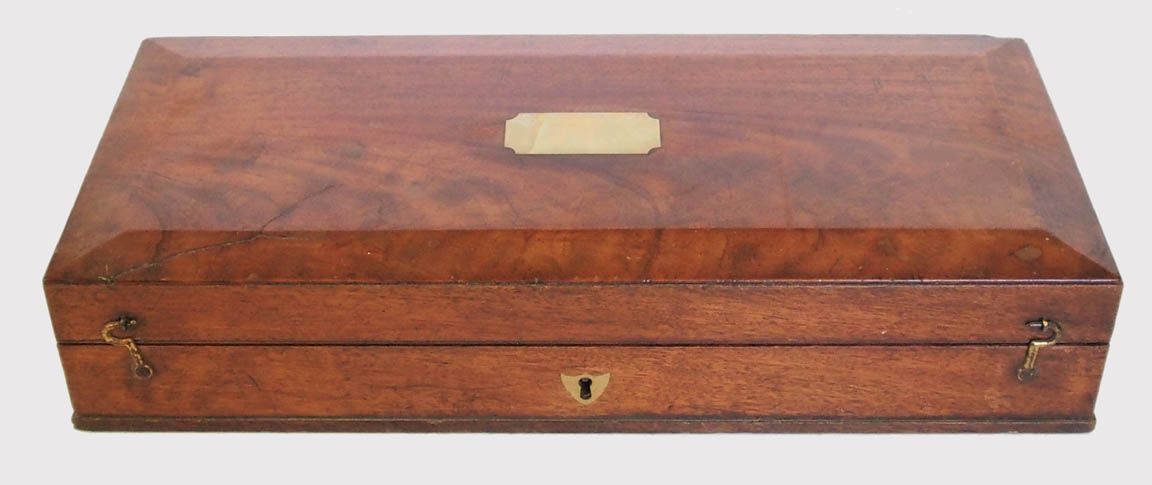 The Regency period bevelled-edge flame mahogany veneer case measures 403 x 175 x 85 mm and the inner lid is lined with purple velvet.
The Regency period bevelled-edge flame mahogany veneer case measures 403 x 175 x 85 mm and the inner lid is lined with purple velvet.
There is a lift-out tray containing the objectives, and a number of the smaller accessories, with the foot, upright rod, and candle holder stored in the bottom of the case. Clicking on the image will lead to a series illustrating the layers of the case. 
CONDITION:
When purchased, the microscope and all its accessories were without lacquer and had been polished. All parts were carefully re-lacquered with shellac dissolved in methanol. It would appear, that the coarse adjustment knob has been replaced with one smaller than the original by a previous owner.
HISTORY OF PHILIP CARPENTER AND MICROSCOPES RETAILED BY HIM:
Although many examples exist which are unsigned, or inscribed with the names of other retailers, this type of microscope has become firmly associated with Philip
Carpenter (1776-1833). He was born in Kidderminster, Worcestershire, as the oldest son in a Unitarian family, which moved to Birmingham in the 1790's. After an apprenticeship as an optician, he started work around 1796, establishing his own business in Inge street, Birmingham in 1808, moving to Bath Row in 1813. He had become a leading supplier of achromatic telescope objectives by 1812, even supplying the reputable firm of Dollond. This established his reputation as an optician
and may explain why in 1817 he became the sole manufacturer of David Brewster's Kaleidoscope, which proved a considerable success. By 1819 he opened additional premises
at 111 New street. He was a man of diverse interests and pioneered a copper plate transfer process which revolutionised magic lantern slide production, and from 1821
Philip was manufacturing the 'Improved Phantasmagoria Lantern' and copper-plate sliders.
Subsequently, his newly acquired wealth enabled him to move his main business to the heart of London in 1826, where he established a shop in 24 Regent street, a fashionable location, where he opened his 'Microcosm' exhibition in 1827. This promised
A grand display of the wonders of nature
. Having earlier engaged in experiments with a view to render the compound microscope better adapted for opaque objects
, this exhibition offered the opportunity to view some 40 or so microscopical objects through '14 Lucernal and Diurnal' microscopes, which were between 6 and 9 feet in length and a foot orF more in diameter. The objects themselves were placed outside in glazed boxes, to be illuminated by daylight; after dusk, however, they were lighted by by means of a flame reflected in a speculum mirror. The admission fee was a considerable 1 shilling, so not affordable for those on a basic wage. The objects were described in a pamphlet A Companion to the Microcosm, published by Carpenter for visitors to the exhibition, and as such, like Benjamin Martin before him, and Andrew Pritchard slightly later, Philip Carpenter ranks as one of the popularizers of the microscope.
It is not surprising, that this environment provided opportunity for 'networking', and it is known that at this time, Philip met C.R. Goring, who was involved in experiments with achromatic, reflecting, and jewel lens microscopes. It is interesting, though not surprising, that an 'Addendum to the Companion' appeared, including both a microscope with an achromatic objective made by Tulley, and a second equipped with Amici-type reflecting objectives made by Cuthbert. An example of a microscope compendium including an Amici-type reflecting-, upright compound-, and Lucernal microscope and signed by Philip Carpenter is in the Golub collection (No 37). In 1823 Goring had commissioned the optician William Tulley to make achromatic microscope objectives for him. This attracted the interest of Joseph Jackson Lister, who in collaboration with Goring developed a series of succesful microscope objectives in the 1823-1830 period and which led to Lister's discovery of aplanatic foci, allowing combining achromatic doublets, so that the the resulting objectives had dramatic improvement in resolution.
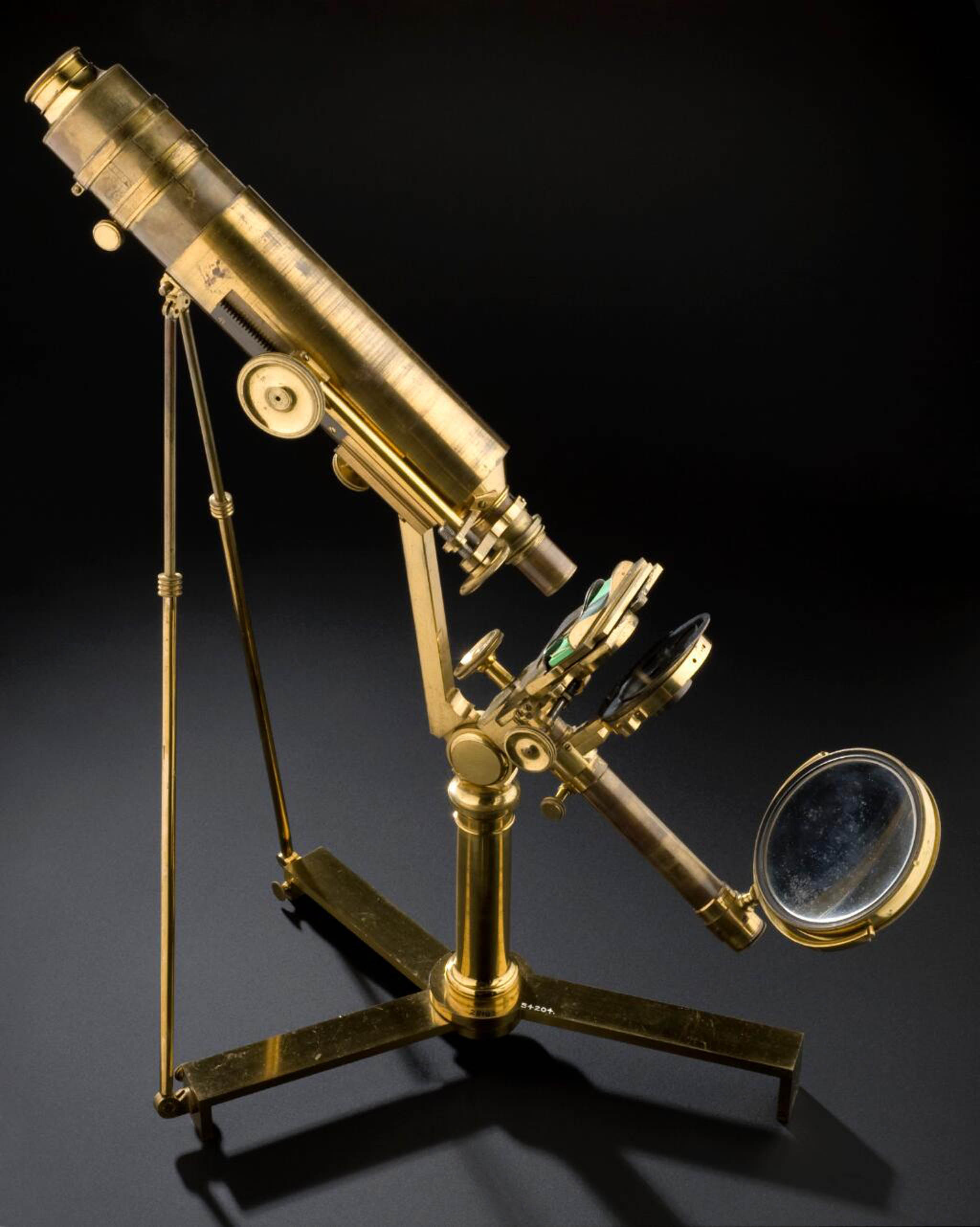
In 1826 Tulley, originally a telescope maker, constructed a new model achromatic microscope for Lister (left), the brass work of which was completed by his foreman James Smith, who was to set himself up as a microscope maker after leaving Tulley's employ in 1838, eventually forming Smith & Beck. It is not surprising, that this very early microscope featured stabilising struts to minimise vibration, as they were commonly employed in telescopes. It is known, that Phillip Carpenter obtained microscopes from 'the trade', including from James Smith in a free-lance capacity, and thus microscopes with the same design characteristics of the Tulley model continued to be sold, some without the stabilizing struts becoming Carpenter's 'Improved', and those, complete with them, being designated his 'Most Improved' model. Typically, the latter were fitted out with a very large array of accessories, and having 6 or 8 chromatic objectives, while usually only one achromatic objective was supplied. An anonymously published booklet, A Description of The New Improved Compound Microscope for Opake and Transparent Objects was also provided, which served as a manual for new owners.
Philip Carpenter died in 1833, the business being continued by his sister Mary, becoming Carpenter & Westley in 1835, in partnership with their foreman, William Westley.
Carpenter's Birmingham based part of the business was sold by his heirs in 1837 to Robert Field, who later formed the partnership of R. Field & Son, makers of the 'Society of Arts' model microscopes, after winning the eponymous prize in 1855. Carpenter & Westley continued to market microscopes of the original Carpenter design sourced from the many small workshops in the Islington and Clerkenwell areas. Carpenter's only known 1834 catalogue notes that 'microscopes are all securely packed in neat French-polished cases'. These featured bevelled edges with flame mahogany veneer to the outer lid, the inner lids lined with plush purple velvet, and these came complete with a set of opaque and transparent slides. A combined bulls eye condenser and candle stand were also included, and customers could have a small oil lamp to be used in lieu of the candle as an optional extra. Whereas some achromatic objectives were sourced cheaply from Nachet in France, examples are known with objectives made by Andrew Ross and Hugh Powell, some being equipped with multiple eyepieces and even a Turrell mechanical stage, with wedge fine focusing to the slide holder.
The Carpenter Improved model continued to be sold into the late 1840's, also to the optical trade, and examples are known retailed by Abraham Abraham (Liverpool), Edward Davis (Liverpool), John Crichton, Joseph Long, , and -as in this example- Thomas B. Matthews (the latter three all based in London). Alongside their Improved model, Carpenter & Westley also sold smaller microscopes, such as the ubiquitous Martin drum, and the Cary-Gould type, either mounted on the case lid, or having tripod folding feet, or supported by a circular brass foot, all packed in smaller versions of their luxury flame mahogany cases, and their hallmark bevelled edges. There is also evidence, that the trade worked in both directions as there are microscopes signed by Carpenter & Westley which are identical in appearance to those manufactured by Abraham & Dancer, probably dating to the period 1841-1845 with their inclining joint just above the distinctive Y-shaped foot (an example is in the Billings collection, fig.64, p.34). The firm also sold larger microscopes,many of which appear to be variations on the standard models as made by Powell & Lealand.
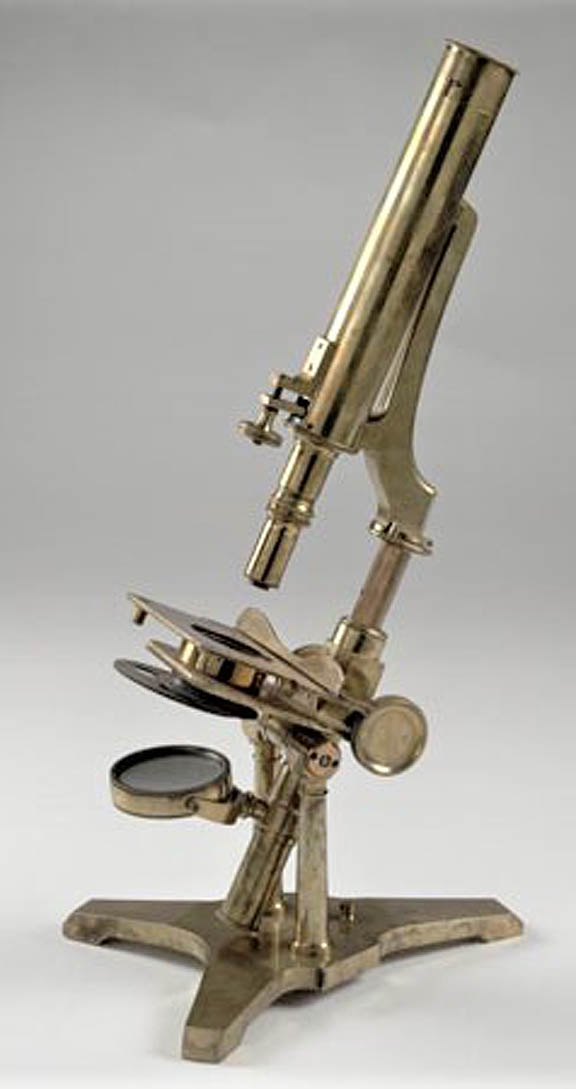
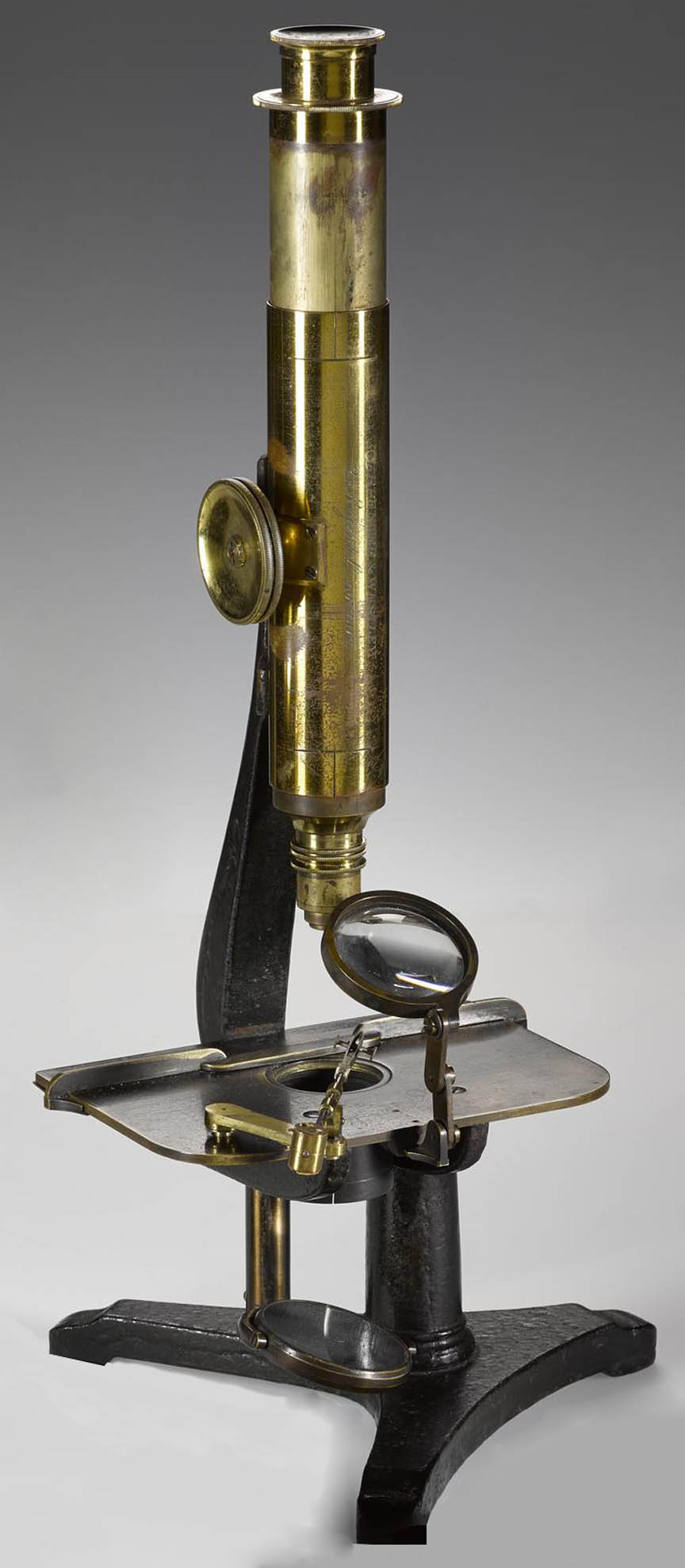
Notable among these is a two pillar model(left), which has an eyepiece of the type made by Hugh Powell (formerly in the Frank collection, now in the National Museums of Scotland). Others sold by C & W, an example of which is shown to the right, show a strong resemblance to the P & L Iron
model, having either the original iron foot, or the whole microscope being constructed in brass but signed Carpenter and Westley
, with or without a Varley stage.
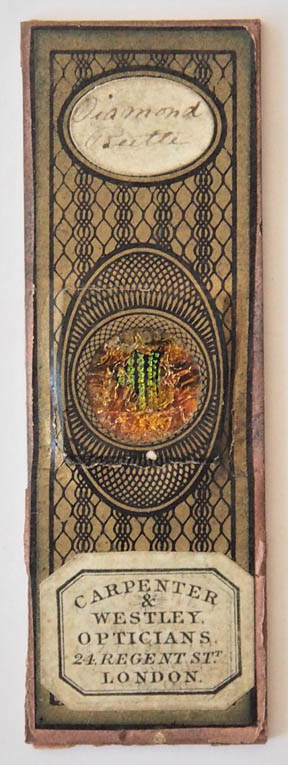
Apart from microscopes, they also sold slides made by professional mounters affixed with their own label, as well as books on the microscope, new and second-hand.
It has been reported, that from the 1860's onwards they sourced their instruments from Negretti & Zambra, so C & W became mainly a retailer. The firm continued to trade at the same 24 Regent street address until 1922, when it moved to 4 Regent street, being there until 1933, when it took over No 1 also.
Of interest is also the family connection with William B. Carpenter (1813-1885), Philip's nephew, who became a reknown physician, invertebrate zoologist, physiologist, microscopist, and author of 'The Microscope and Its Revelations', the well-known standard work which went through 8 editions between 1856 and 1901, the last two of which were edited by the Rev. Dallinger.
BIBLIOGRAPHY
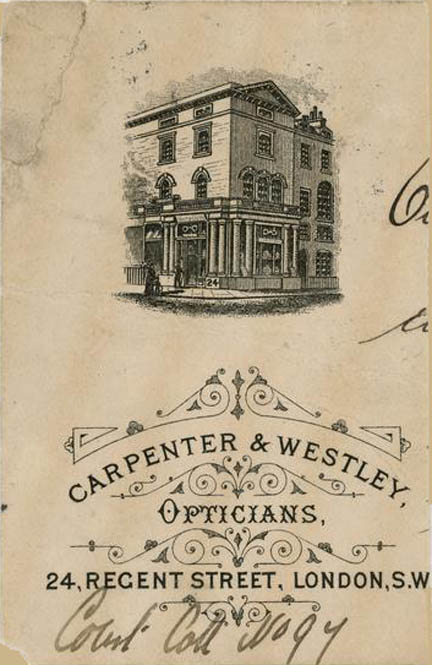
Bracegirdle, B. Notes on Modern Microscope manufacturers. Quekett Microscopical Club 1996
McCormick, J.B, and Turner, G.L'E. The Atlas Catalogue of Replica Rara Ltd. Antique Microscopes.1975. Replica Rara Ltd.
Nuttall, R.H. James Smith, and Smith and Beck; 1839-1852. Part I: The Microscopes. Microscopy 36, July-December 1989
Nuttall, R.H. Philip Carpenter and the 'Microcosm' Exhibition; with a note on Carpenter and Westley's Microscopes. Microscopy 33, July-December 1976
Nuttall, R.H. Microscopes from the Frank Collection 1800-1860. A. Frank, Jersey, Channel Islands. 1979
Purtle, H.R. The Billings Microscope Collection of the Medical Museum Armed Forces Institute of Pathology. Second edition, Washington D.C. 1974
Roberts, P. The Early Life of Philip Carpenter. The Magic Lantern, No 6, March 2016, pp.10-13. (Journal of the Magic Lantern Society, see: www.magiclantern.org.uk).
Talbot, S. 'The Perfectionist Projectionist': Philip Carpenter, 24 Regents Street, London. Bulletin of the Scientific Instrument Society. No 88 (2006) pp.17-20.
Turner, G.L'E. Powell & Lealand: Trade Mark of Perfection, in: Essays on the History of the Microscope. 1980. Senecio Publishing Company Ltd, Oxford.
Turner, G.L'E. Collecting Microscopes. Christie's International Collectors Series. 1981. Mayflower books.
Turner, G.L'E. The Great Age of the microscope.1989. dam Hilger, Bristol and New York.
 This is an example of an Improved Compound Microscope, probably produced for Carpenter & Westley, but signed on one of the folding feet by another retailer, T.B. Matthews, 9 Athol Place, Pentonville, London (according to Gloria Clifton, T.B. Mathews is known to have worked as an optician from 1845-1849).
This is an example of an Improved Compound Microscope, probably produced for Carpenter & Westley, but signed on one of the folding feet by another retailer, T.B. Matthews, 9 Athol Place, Pentonville, London (according to Gloria Clifton, T.B. Mathews is known to have worked as an optician from 1845-1849). 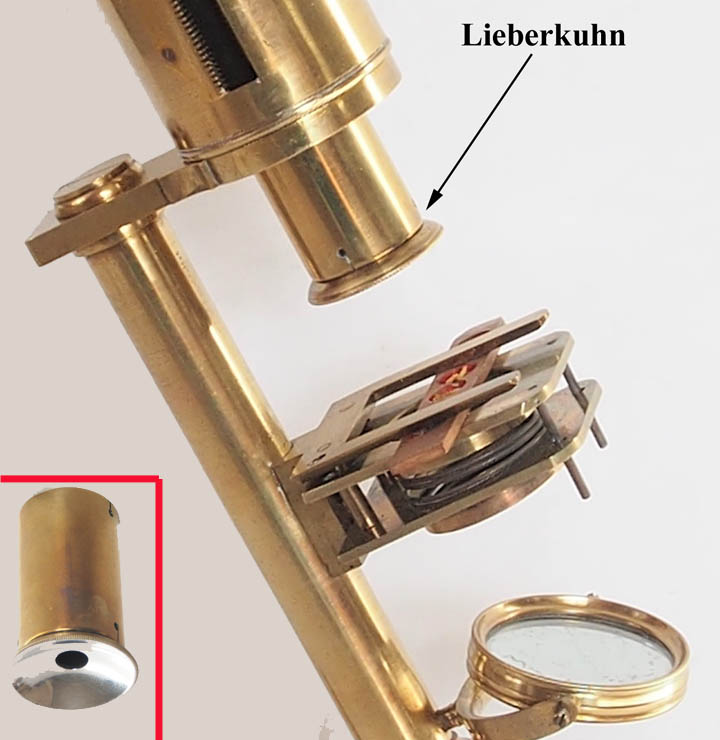
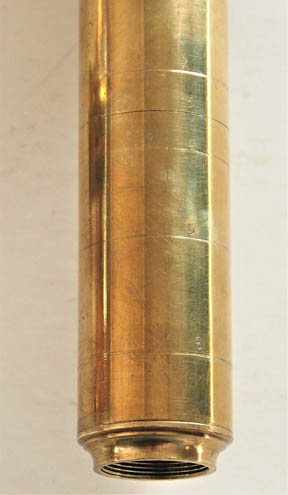 The flat folding tripod feet are each of different lengths so as to allow them to fold up. They measure 215, 117, and 108 mm from their centers to their ends respectively. The tripod supports, via a compass joint, a 148 mm tall round pillar with an arm at the top which carries the body tube. The coarse focusing arrangement resembles that as used in Martin drum microscopes of the mid 19th century, and also some early 19th century Culpeper types; it works by rack and pinion, with rackwork between a fixed outer cylinder and an inner tube in which slides the optical tube and nosepiece assembly. There is no fine focus. The square stage(left) is sprung, holding the slide against a stationary U-shaped fork while at the same time forming a
The flat folding tripod feet are each of different lengths so as to allow them to fold up. They measure 215, 117, and 108 mm from their centers to their ends respectively. The tripod supports, via a compass joint, a 148 mm tall round pillar with an arm at the top which carries the body tube. The coarse focusing arrangement resembles that as used in Martin drum microscopes of the mid 19th century, and also some early 19th century Culpeper types; it works by rack and pinion, with rackwork between a fixed outer cylinder and an inner tube in which slides the optical tube and nosepiece assembly. There is no fine focus. The square stage(left) is sprung, holding the slide against a stationary U-shaped fork while at the same time forming a 
 These include a slip-on brass collar with Lieberkuhn at the end, hand magnifier, live box, a small brass box, stage forceps, tweezers, a glass trough with brass rim, and a diaphragm stop to be inserted under the stage. There is also a combined candle stand and bullseye condenser finished in oxidized brass. This uncommon and uniquely-Carpenter type of illuminant features a two component, screw-together lens, the components to be used together for opaque specimens, but just one for illuminating the mirror.
These include a slip-on brass collar with Lieberkuhn at the end, hand magnifier, live box, a small brass box, stage forceps, tweezers, a glass trough with brass rim, and a diaphragm stop to be inserted under the stage. There is also a combined candle stand and bullseye condenser finished in oxidized brass. This uncommon and uniquely-Carpenter type of illuminant features a two component, screw-together lens, the components to be used together for opaque specimens, but just one for illuminating the mirror. 
 The Regency period bevelled-edge flame mahogany veneer case measures 403 x 175 x 85 mm and the inner lid is lined with purple velvet.
The Regency period bevelled-edge flame mahogany veneer case measures 403 x 175 x 85 mm and the inner lid is lined with purple velvet. 
